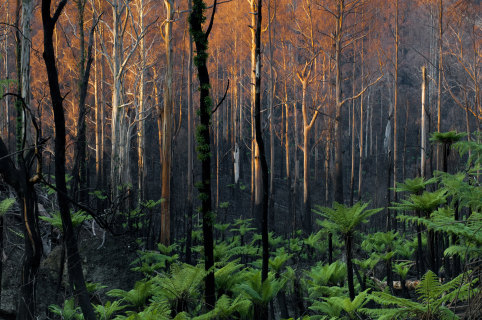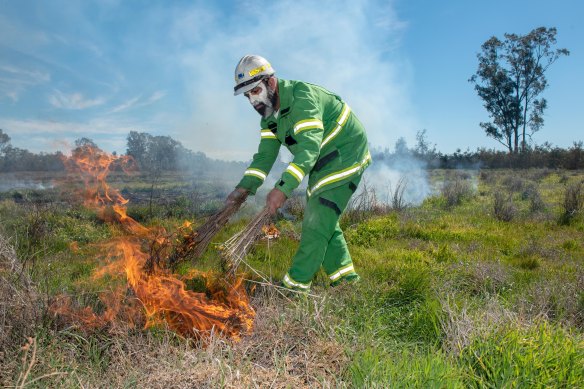To burn or wait for an inferno? The oldest riddle of the forest
Save articles for later
Add articles to your saved list and come back to them any time.
My grandfather, who rode a big horse called The General, was out in the forest on a cool, autumn morning in the early years of last century when he became aware he was being observed.
Up on a ridge sat a Forests Commission inspector, a ghostly figure mounted on a grey horse.
Lush regrowth after fires.Credit: Christian Pearson/DSE
This was not a glad sight for my grandfather. He was dribbling fire across the forest floor from a lit wick on a long handle, as he always did in autumn.
This was outlawed in Victorian state forests after the appointment in 1908 of a Conservator of Forests, and the subsequent creation in 1918 of the Forests Commission Victoria.
The commission’s first chairman was a young Welsh-born and English-trained forester named Owen Jones. He was intent on preserving forests and suppressing fires, not putting a torch to them. His commission’s inspectors were sent out to apply the law.
My grandfather snuffed out his flame and put spurs to The General, hurdling logs and fences to reach his property a few kilometres away, where he called urgently for my grandmother to load a cart with calves while he stripped his mount of the saddle.
And so, with the load of calves drawn by a cart horse, my grandparents set off, an apparently innocent farm couple heading to the monthly livestock market, reducing the poor inspector to powerless frustration when he caught up with them.
The inspector and cattlemen such as my grandfather were at impossible cross purposes.
The forestry official was doing the best he could under the rules of the time to protect the landscape.
My grandfather, who held a lease to run cattle in the forest, was doing what he could to promote the growth of fresh grass among the trees. He was using “cool” slow fire to prevent much more destructive hot fire.
My grandfather was … using ‘cool’ slow fire to prevent much more destructive hot fire.
My father, when he was 14, accidentally set a fire leaping while he was herding cattle through that same forest.
I have him on video telling the story before he died.
He finished, nonchalantly, by relating that the fire ran only until “it reached the next burnt patch”.
His family burnt the forest in a mosaic pattern, year on year, meaning a major fire couldn’t get a good run before it ran out of fuel.
“Who taught you that?” I asked my father. He acknowledged his family must have learned it from the Aboriginal people who lived and hunted across south-west Victoria until families like ours sailed in from Britain.
Mick Bourke lights a fire using traditional methods in Boort, Victoria, in September 2019.Credit: Brendan McCarthy/DELWP
White Australians began to understand only relatively recently a bit about the sophisticated firestick stewardship of the land by Australia’s Indigenous people.
Bill Gammage’s 2011 work, The Biggest Estate on Earth: How Aborigines Made Australia, put together evidence of how the intelligent use of fire had shaped the land’s ability to support life without the catastrophic bushfires that have become familiar to modern Australians.
Gammage, a historian at the Australian National University, found a common description of the Australian landscape among the first Europeans to arrive was that of a “gentleman’s estate in England”.
Tower Hill circa 1855, by painter Eugene von Guerard.
Those first Europeans wrote of wide grassed valleys alive with the yellow flowers of murnong, or yam daisies, open woodlands and bountiful wildlife.
Forested areas had nothing like the tangled understory that we consider today to be “untouched wilderness”.
All of it, Gammage proposed, was sculpted by flame before colonisation meant Indigenous people could no longer tend much of their country and the land became overgrown and exposed to uncontrolled fires.
Today’s fire management authorities have, of course, returned to significant programs of strategic planned burning as part of their array of techniques to try to prevent wild fires.
Victoria’s Bushfire Risk Management Report for 2021–22 shows Forest Fire Management Victoria and the Country Fire Authority completed 435 planned burns across 65,480 hectares, with a further 16,058 hectares of fuel slashed or mowed and 741 kilometres of fire breaks built or upgraded.
It sounds impressive – until you consider Victoria has about 8.2 million hectares of forest.
Australia has changed so profoundly in a couple of hundred years – with dramatically increased population, farmland abutting forests, tree-changers valuing bushland around their homes, environmentalists wishing to protect the habitats of native animals and settled communities averse to smoke hazes – that it seems all but impossible to imagine returning to a system whose roots pre-date European settlement.
And now, topping everything, climate change has massively increased the risk of uncontrolled fires.
This week’s brief bushfires in Gippsland burnt out perhaps a third as much country as authorities burned on purpose across the state in 2021-22 to reduce fuel loads. They are suspected to have occurred when fires lit by property owners trying to clear their land of fuel ahead of the “normal” fire-danger period got away when unexpected heat and wind hit.
And then they were extinguished by a sudden flood.
Could the climate be any more viciously ironic?
As we are drawn into a new El Niño and who knows what terror from our changing climate, my grandfather’s exploits seem pretty tame, if not desirable.
Sometimes, I remember the soft grass underfoot that was still in that canopied forest when I was a child in the 1950s, and I yearn a bit for it, knowing much bushland now, despite the “strategic burning” here and there, sits deep in fallen branches and peeled bark and tangled scrub, waiting …
Most Viewed in National
From our partners
Source: Read Full Article


